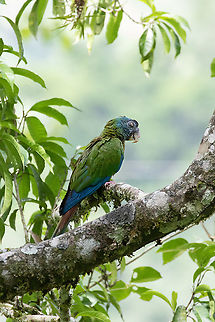
Appearance
The blue-headed macaw is 41 cm long. It has mainly green plumage with the head, flight feathers and primary coverts blue. The uppertail has a maroon base, a narrow green center and a blue tip. The undertail and underwing are greenish-yellow similar to that of several other small macaws.The medium-sized bill is pale greyish-horn with a black base. The iris is whitish with a narrow, often barely visible, maroon eye-ring. Unlike most other macaws, the facial skin and lores are dark greyish. The legs are dull pinkish. Juveniles resemble adults, but with the entire bill black, greyer legs, darker iris and the facial skin and lores white.

Behavior
Little is known about its reproductive behavior in the wild, but a possible nest has been recorded in a bamboo cavity and another in a tree cavity. In captivity, the reproductive cycle appears to be roughly annual with a clutch size of 2-4 being the norm. In the wild it is typically seen in groups of 2-4 individuals, with occasional records of groups up to c. 60 individuals. Its call is higher-pitched and softer than that of most other macaws.Habitat
It is found in the south-west Amazon and adjacent east Andean foothills. It prefers openings in humid forest, e.g. along rivers or clearings, but has also been observed in Moriche Palm swamps and outskirts of towns. It occurs from the lowlands up to an altitude of 1550 m . As several other parrots, the blue-headed macaw is known to visit clay-licks.References:
Some text fragments are auto parsed from Wikipedia.